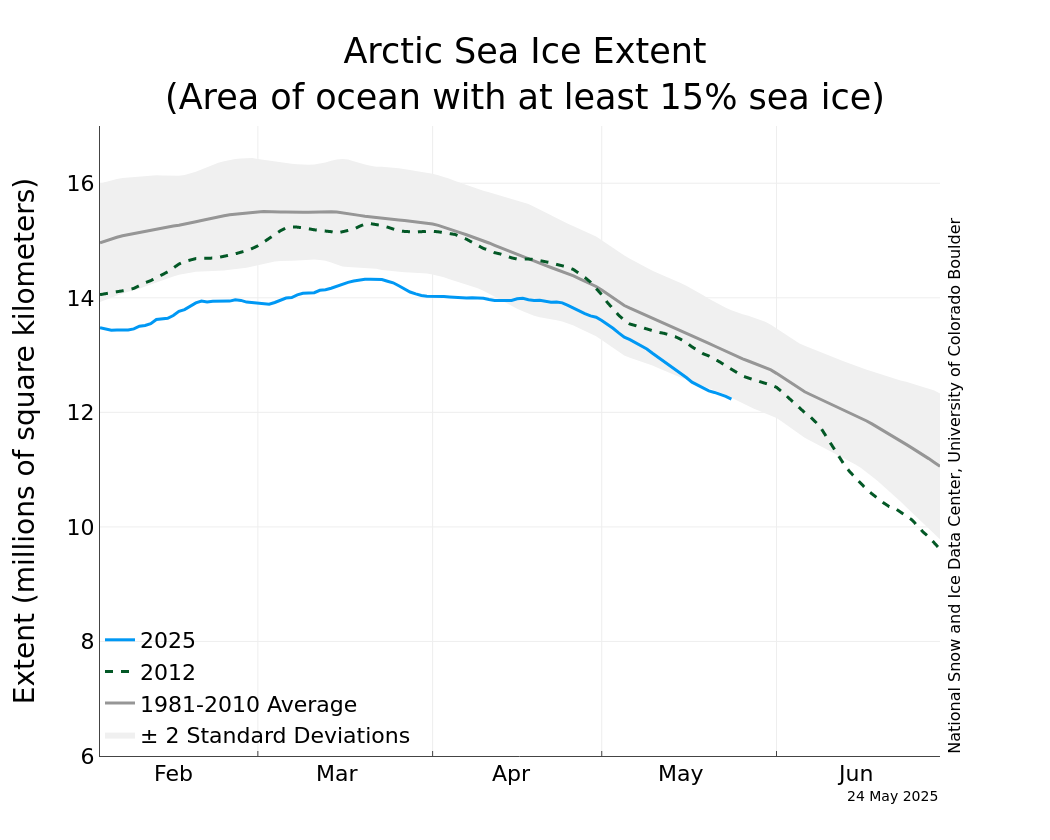... as it happened before, without greenhouse effects, what makes it so sure that this time it must be the greenhouse. How about a interaction of the Arctic Oscillation and the North Atlantic Oscilation, combined with other effects?
I'm not 100% sure it is, especially as I tend to be skeptic bout many claims, but the rate of floating Arctic ice mass melting (more than half melted in the last decade, I think.) does seem to be too fast for any other explanation.
I have many times posted that it is the un-precedented* RATE of CO2 release and the never before observed by man, bubbling up of CH4 in dense (sub sonar killing) Arctic Ocean bubble clouds that concerns me that we may be making a possible great disaster for mankind (and other warm blooded animals that cool by evaporation as being in a wet-bulb environment of only 35C will kill you in less than an hour and due to increased ocean evaporation, the amount of rain and average air humidity is increasing now.) The fact that increasing atmospheric concentrations of CH4, increase the half life of CH4 in the air and CH4 is at least 10 times better IR absorber than CO2 is sort of scary too.** - If present rates of CH4 continue, even neglecting their self- accelerations, then in a few decades at most, CH4 will be a more important GHG than CO2.
* Except perhaps during large volcanic eruptions.
** Currently the CO2 concentration, in ppm, is ~ 400 and that of CH4 averages ~1.816 (data sources and more discussion in post 909). So there is 400 / 1.816 = 220 times less CH4 concentration than CO2 in the air, and CH4 absorption is still in a linear absorption-function concentration range. If the CH4 concentration were to increase by a factor of only 1.85/0.51 = 3.627 to an average concentration of 6.59 ppm then it would be as important as CO2 is now and still in the linear function range. CH4 is the real GHG threat, not CO2, that all focus on.
That is why I think it is imperative that man switches away from petroleum ASAP as burning it seems to be a very likely cause for rapid rise in both CO2 and CH4 atmospheric concentrations. How to easily*** do this is well known: Demonstrated in Brazil for more than 3 decades to be both practical and even more economical than using gasoline as car fuel on a per mile driven basis!
The volume of alcohol fuel needed to fuel all the world's cars, even if cellulosic alcohol does not prove to be economically competitive with that produced from sugar cane, can be produced with only about 2% of the earth's arable land growing sugar cane. (Or less than 1% of Earth's "agricultural land.") The advances of modern agriculture can increase the yield per acre, compared to the primitive means used in large areas, by at least 20% so while switching to sugar cane based alcohol, there could be also at least a 10% increase in the production of food and fiber.
*** Only trivial modifications to the current factories producing liquid fuel IC engine cars are required to switch to alcohol fuel. The cost of switching factories to that production would be at least 10 times less than switching to factories producing battery powered cars and even converting almost all existing gasoline car to alcohol fuel is a small: <3% of their cost,
why not do this, to be safe?
PS - Want to know why more economical than gasoline alcohol fuel is not already the norm? Answer: Vested interest "big oil" lies: Say that switching to alcohol would destroy the rain forests. Big oil also diverts public attention from the facts they don't like by promoting alternate fuels like hydrogen that can never compete economically with their gasoline. Go ahead,
Sucker, fill up with gasoline and pay higher taxes so Big Oil can get its "depletion allowances," and other subsides you pay them as well as paying more at the pump than you need to!




